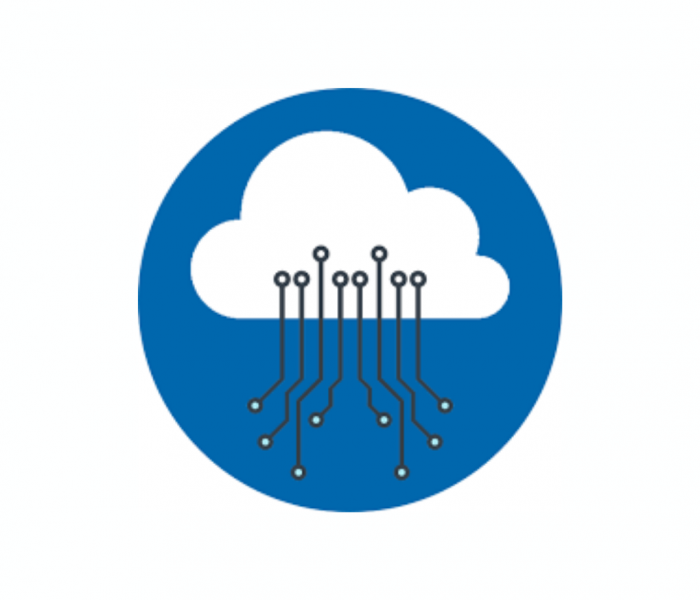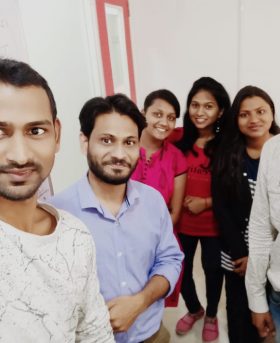Cloud Computing
Cloud Computing
What is Cloud Computing?
Cloud computing is one the most innovative technology of our time. Before emerging the cloud computing, there was Client/Server computing which is basically a centralized storage in which all the software applications, all the data and all the controls are resided on the server side. At around in 1961, John MacCharty suggested in a speech at MIT that computing can be sold like a utility, just like a water or electricity. Cloud allows us to quickly and easily access store information anywhere, anytime in the whole world, using an internet connection. An internet cloud infrastructure increases organization productivity and efficiency by ensuring that our data is always accessible.

Cloud Computing Course Eligibility
Freshers
BE/Bsc Candidates
Any Graduate
Any Post-Graduate
Key features
Flexible schedule
Morning, Afternoon, Evening Batches Available. On Weekdays and Weekend Slots.
Interview Preparation
Mock Interview session practice from industry experts panel.
Resume Preparation
One to one CV building from experts.
Live Project Training
Hands-on projects on every module.
Practice Course Material
Authorized course material with industry standards.
Syllabus of Cloud Computing Course
Fundamentals of Cloud Computing
- Why Cloud and What is Cloud Computing?
- Identify the features and benefits of cloud computing
- Different types of Cloud Computing deployment model
- Public Cloud, Private Cloud, Hybrid Cloud
- Virtualization – An essential in cloud
- Virtualization in Cloud model
- Different types of virtualization
- Hypervisor – Benefits
- Different types of services and its difference in Cloud computing
- IaaS, PaaS, SaaS
- Importance of scaling in cloud computing
- Different types of scaling and its applications
- Issues we overcome using cloud and applications
- Cost model that we use in cloud computing
- Overview of all basic commands
- Vim editor modes
- Filesystem hierarchy – Basic topics
- File and directories creation
- Grep
- Filter commands (head,tail,more,less)
- Creating users and groups
- Important files related
- Modifying,deleting users and group
- Linux permissions
- Basic permissions overview
- Software management
- Yellowdog update modifier(yum)
- Yum commands
- Different runlevels
- Services and daemons
- Describe the features of AWS
- The features of AWS marketplace
- Describe the features of Amazon Compute Services
- Describe the features of Amazon Storage Services
- Describe the features of Amazon Network Services
- Describe the features of Amazon Database services
- Describe about various services in AWS
- Global Infrastruture – Regions and Availability Zones
- Create a free tier account in AWS and onboarding
- Introduction AWS management console
Understand Identity Access Management of AWS
- Protect your AWS by different authentication system
- Password policies set for users
- AWS User Account and Groups in detail
Creating custom policies in AWS
- Introduction about Roles and its use
- Creating Roles and associating policies
- Creating programmatic access and management console access for users
- Associating policies to the user and groups
- Describe AMI and AWS Marketplace templates
- Launch a basic EC2 instance
- Different types of Instances Reserved, On-demand, Spot, Dedicated
- Security groups and tags for EC2 instance
- Public key – Private key introduction and protecting EC2 with keys
- Attaching and detaching EBS volumes
- Launch an ec2 instance from an AMI
- Create custom AMI and working with different region
- Make use of amazon EBS volume and create snapshots
- Manage the configuration of your application
- Deploying a new instance from the created AMI
- Get Started with Auto Scaling Using the Console
- Creating Launch configurations and make use of it for autoscaling groups
- Maintain a Fixed Number of Running EC2 Instances
- Dynamic Scaling
- The lifecycle of autoscaling
- Policies of autoscaling
Load Balancing
- Introduction to Loadbalancer (ELB)
- Different types of Loadbalancer in AWS
- Application Load balancer
- Network Load balancer
- Classic Load balancer
Migrating classic load balancer to new load balancer - Components and types of load balancing
- Introduction to Loadbalancer (ELB)
- Different types of Loadbalancer in AWS
- Application Load balancer
- Network Load balancer
- Classic Load balancer
Migrating classic load balancer to new load balancer - Components and types of load balancing
- Create EBS volumes
- Delete EBS Volumes
- Attach and detach EBS volumes with EC2 instance
- Creating and deleting snapshots
- Understanding S3 durability and redundancy
- Introduction about S3 Buckets
- How S3 Uploading works and how to Download
- How to S3 Permissions
- How to implement S3 Object Versioning S3 Lifecycle Policies
- Storage Gateway
- Import Export
- S3 Transfer Acceleration
- Glacier storage
- Describing cloud front
- Creating a cloud front distribution
- Hosting a website of cloud front distribution
- Implementing global restrictions
- Configuring origins and behaviors
- Describe Hosted zones and Domain name understanding
- How to create hosted zones
- Hosting a website with custom domain name
- Understanding routing policies
- Describing Security Practices for Cloud Deployment
- AWS Shared Responsibilities and Securities
- Importance of Cloud Trail
- Describing Trust advisor
Amazon Virtual Private Cloud (VPC)
- Introduction to Amazon Virtual Private Cloud (VPC).
- VPC Advantages and understanding IP addressing CIDR
- Default and Non-default VPC
- Different Components in VPC
- Describe, create, and manage Amazon Virtual Private Cloud
- Amazon VPC, Private Subnet, and Public Subnet
- AWS Networking, Security Groups, and Network ACLs
- Configuration and management of VPN connectivity
Relational Database Service (RDS)
- Introduction to RDS
- Different database services of AWS: Amazon RDS, Dynamo DB, Redshift etc.
- Create MYSQL RDS Instance, Oracle RDS Instance, MS SQL RDS Instance
- Configuring the database
- Configuring backups
- Configuring the maintenance windows
- Connecting to the database
- Adding data manually
- Learn about strong and eventual consistency
- Calculating Read write consistency
- Configuring alarms
- Knowledge on Cloud watch – A monitoring service
- Create and Configuring Monitoring services
- How to perform Setting thresholds and Configuring actions
- Creating a cloud watch alarm
- Getting statistics for ec2 instances
- Monitoring other AWS services
- Configuring Notifications
- Integrating cloud watch with Autoscaling
Application Services – An Overview
- What is SNS
- Creating a topic
- Create subscription
- Subscribed to the subscription
- SQS & SES
- Lambda and Elastic Beanstalk
- Troubleshooting EC2 instance
- Troubleshooting using Cloud watch
- Troubleshooting using ELB
- Troubleshooting by using Cloud front
- Backup and Disaster Recovery
- How to manage Disaster Recovery and Backups
- Best Practice for DR and Backups
- AWS High Availability Design
- An understanding of DevOps and the modern DevOps toolsets
- The ability to automate all aspects of a modern code delivery and deployment pipeline using:
- Source code management tools – CVS, Git
- Build tools – Apache ant, Maven
- Test automation tools – JUnit
- Continuous Integration Tools – Jenkins, Team city
- Configuration management tools – Chef, Puppet, Ansible
- Pre-Migration practices usage and learning
- AWS Migration Strategy
- Stack creation using an AWS CloudFormation template
- AWS CAF (Cloud Adoption Framework)
- Application Migration To AWS
- Migrating an on premise Server or VM to cloud.
- Server Migration services;
- Agent based and agentless server migration service
- igrating on Premises Hyper VM to AWS AMI
- Migrating on Premises VMware VM to AWS AMI
- Migrating an on premises VM machine to AWS environment
- AWS Database Migration services & challenges
- Usage of pre & post migration activities by using AWS
- portfolio of DB migration services
- Migrating a database from outside the AWS environment to target AWS RDS
- mazon Aurora DB within AWS environment:
- Transferring data to AWS in large scale
- Speeding up a large-scale data migration to S3 by enabling S3 Acceleration
- Docker Ecosystem usage
- Understanding the ECS usage in Docker
- Docker package usage in a monolithic application inside docker container services
- AWS elastic container service(ECS) used to migrate monolithic application to AWS Cloud
- Purpose of Storage Gateway
- Snowball & Snowball edge services
- Direct Connect tool usage
- Introduction to DevOps
- DevOps Principles in detail
- DevOps Engineer Skills in the market
- Knowing DevOps Delivery Pipeline
- Market trend of DevOps
- DevOps Technical Challenges
- Tools we use in DevOps
- Knowing about Version control
- Git – A CLI
- Essentials of GIT in industry
- How to setup GIT
- Installing Git
- First-Time Git Setup
- Getting a Git Repository
- Working with various commands in GIT
- Recording Changes to the Repository
- How to check the Status of Your Files
- How to track New Files
- Staging our modified files
- Ignoring Files from GIT
- Viewing Your Unstaged and Staged Changes
- How to commit Your Changes
- Skipping the Staging Area and commit
- Removing Files from GIT
- Viewing the Commit History
- Limiting Log Output
- Using a GUI to Visualize History
- Undoing Things
- hanging Your Last Commit
- Unstaging a Staged File
- Unmodifying a Modified File
- Working with Remotes
- Showing Your Remotes
- Adding Remote Repositories
- Fetching and Pulling from Your Remotes
- Pushing to Your Remotes
- Inspecting a Remote
- Removing and Renaming Remotes
Batch Schedule
Students Reviews & Testimonials
Some Happy Faces from Our Recent Batch




Some of our top partners








Previous
Next
Career Opportunities
Cloud Security Engineer.
Hyderabad, India
Cloud Architect.
Pune, India
Cloud Developer.
Mumbai, India
Network Engineer (Cloud)
Pune, India
Cloud Security Engineer.
Bangalore, India
